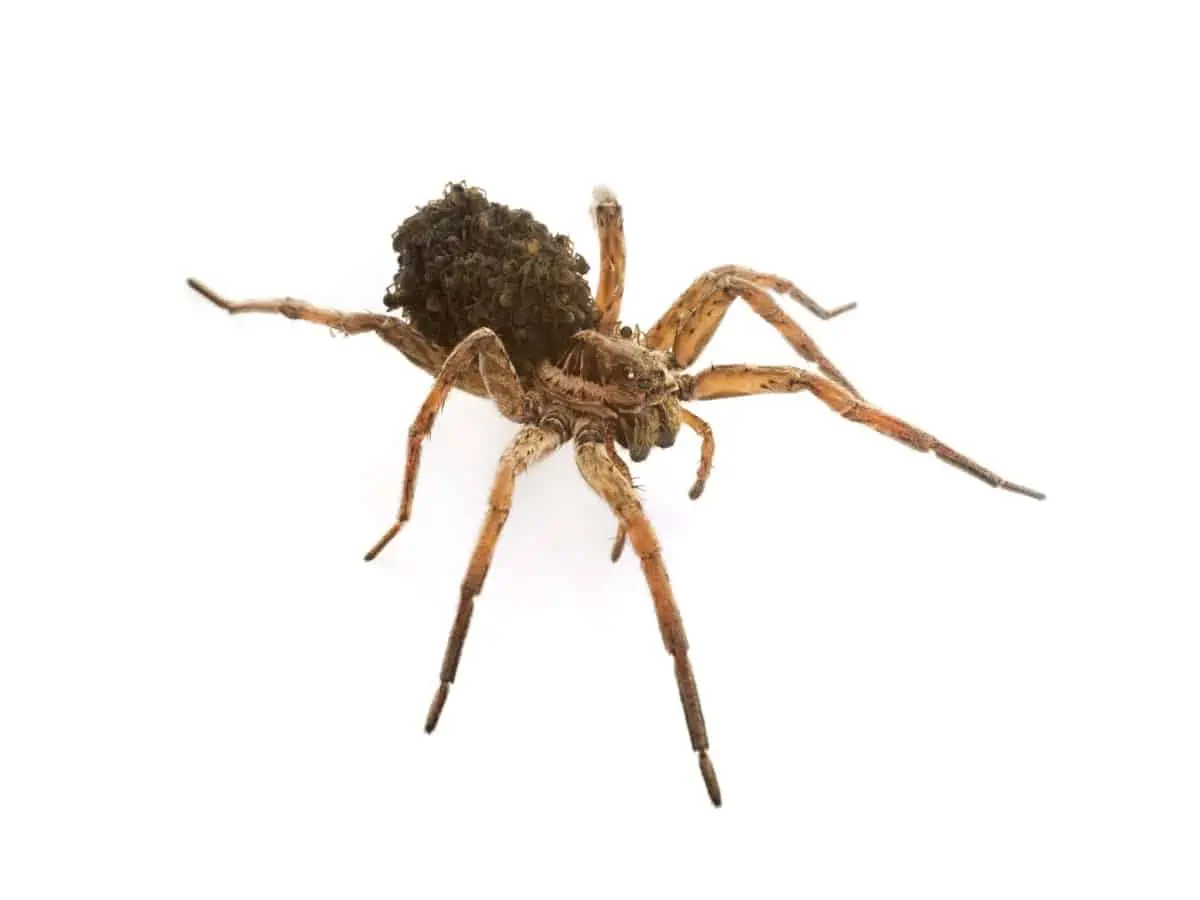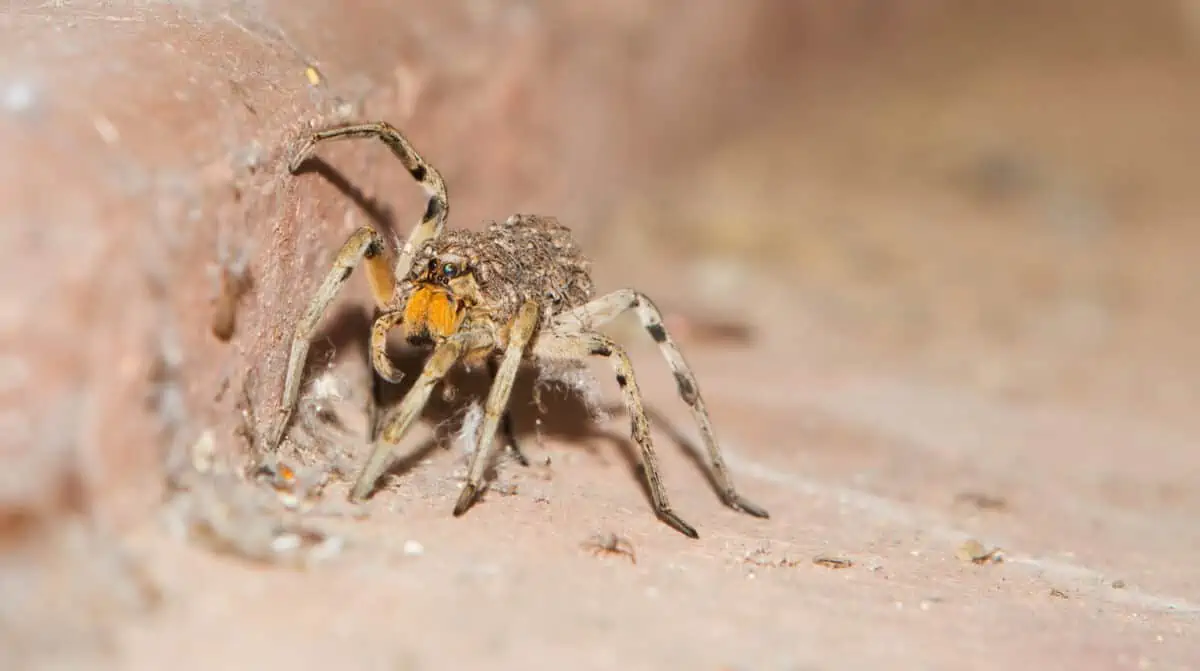Share the post "Wolf Spiders in Texas (Scary Creepy Hunters)"
It’s not uncommon to find wolf spiders in Texas. Yet, identifying those pesky intruders and knowing how to deal with them is still challenging for many people.
While Texas wolf spiders are incredibly fast and scary-looking, they aren’t as dangerous as they seem. However, they can pose some risks for specific population segments, so you might want to keep them away to be on the safe side.

Texas Wolf Spiders: Species Overview
Wolf spiders are part of the Lycosidae family. Since they’re agile and robust hunters, many consider the wolf spiders to be the sprinters of the spider world.
Most of the spiders in this family are so fast that they don’t even need to spin webs to catch their prey. Instead, they can chase the prey and pounce on it to catch it.
Then the wolf spiders will inject their venom inside the prey, killing it in no time. Thankfully, they don’t pose the same threat to humans. While some members of this family are poisonous, their poison has a very mild effect on humans.
There are numerous types of wolf spiders in Texas. Most of the wolf spiders in Texas are the Rabidosa rabida species, also known as the rabid wolf spiders.
You can also find other species of wolf spiders in Texas, including:
- Santa Rosa wolf spider (Arctosa sanctaerosae)
- Field wolf spider (Hogna lenta)
- Carolina wolf spider (Hogna carolinensis)
- Wetland giant wolf spider (Tigrosa helluo)
- Shoreline wolf spider (Arctosa littoralis)
How Can Texas Wolf Spiders Harm You
Typically, wolf spiders are pretty harmless. Other than looking somewhat intimidating, there’s nothing major to worry about, but there might be special cases that are particularly sensitive.
You should avoid touching those creepers since they can inject a toxin into your body. While this poison is mild and unlikely to cause any real harm, some people are allergic to spider bites.
Although this isn’t a direct harm, around 3% to 15% of the population suffer from arachnophobia, which is the fear of spiders. If anyone with arachnophobia spots one of these scary-looking arachnids, they’ll be extremely anxious and may have trouble functioning.

What Texas Wolf Spiders Eat
Wolf spiders love all sorts of insects and bugs, which are abundant in most parts of Texas. Additionally, larger wolf spiders can eat bigger meals. Therefore, they can eat small lizards and frogs.
For the most part, the wolf spiders’ diet consists of bugs, including:
- Crickets
- Ants
- Grasshoppers
- Other spiders
- Flies
- Cockroaches
- Centipedes
Identifying a Texas Wolf Spider
Most people confuse wolf spiders for tarantulas or fishing spiders, mainly because the wolf spider is hairy. However, this species couldn’t be further apart than other arthropods.
Here are a few pointers to help you out with the identification:
Eyes
To start, the Texas wolf spider has a distinct eye arrangement. If you’re able to get close enough, you’ll see two small eyes at the top of its head, two large ones in the front, and four small eyes at the very bottom.
Hunting
This species is unique because it lacks the most well-known trait among spiders. Believe it or not, a wolf spider doesn’t make webs!
Generally, spiders make webs to lay eggs or catch prey. On the other hand, the wolf spider hunts its prey. As for the eggs, the mother spider carries them in a sack by the belly, much like a kangaroo!
So, if you spot a spider near a web, it’s unlikely that it’s a wolf spider. Instead, you’re more likely to find them in dark nooks and crannies where they can catch their prey.
What to Do When You Find a Wolf Spider
First off, don’t squish wolf spiders, as it’s a sure way to release the spider’s eggs. That’s because the eggs are found within the female spider. So, you’ll be looking at eliminating tens of spiders instead of one.
The best way to deal with any spider is by simply covering it with a glass container. Then, you’ll need to slide a piece of paper underneath the jar to trap the spider.
After that, you can flip the container over while keeping the paper on top. This way, you can release the spider anywhere away from your house. If the spider has already bitten you, you might want to keep it in the jar to get an expert to confirm the species.
How to Keep Texas Wolf Spiders Away from Your Home
If you’re constantly finding wolf spiders around your home or having trouble getting rid of them, contacting pest control professionals is best. You might also want to prevent them from getting inside in the first place.
Let’s check some simple tips and tricks to prevent Texas wolf spiders from entering your home.
- Trim your grass and bushes, as spiders love to hide in tall grass.
- Block any possible entry point around the windows and doors. You can use caulk and weather stripping.
- Add door sweeps under your door.
- Vacuum, mop, or sweep your house at least once a week and focus on the corners.
- Don’t use outside lights for extended periods, as they can attract all sorts of insects.
- Install tight-fit lids on your trash cans.
Texas Wolf Spiders: FAQs
Where do wolf spiders hide in homes?
If a wolf spider makes it inside your home, it’ll usually hang out around garages, windows, or doors. They also love to hide in houseplants. In most cases, they’ll be hanging as close to the ground as possible. So, it’s unlikely that you’ll find a wolf spider hanging around your ceiling.
What plants repel the Texas wolf spider?
Generally, spiders don’t like the scent of lavender. So, by growing lavender close to the entrances of your house, wolf spiders will feel unwelcome. You can also grow eucalyptus and peppermint since they’re both low maintenance.
How can I make a wolf spider repellent spray?
You can make a wolf spider repellent spray using peppermint oil, cinnamon, dish soap, and water. Just mix these ingredients in a spray bottle, and you’re good to go.
References
- Wolf spiders are pretty harmless: webmd.com
- 3% to 15% of the population: my.clevelandclinic.org
- Wolf spiders’ diet: reptilepark.com.au
Share the post "Wolf Spiders in Texas (Scary Creepy Hunters)"
Christian Linden is a seasoned writer and contributor at Texas View, specializing in topics that resonate with the Texan community. With over a decade of experience in journalism, Christian brings a wealth of knowledge in local politics, culture, and lifestyle. He holds a Bachelor's degree in Communications from the University of Texas. When he's not writing, Christian enjoys spending weekends traveling across Texas with his family, exploring everything from bustling cities to serene landscapes.











